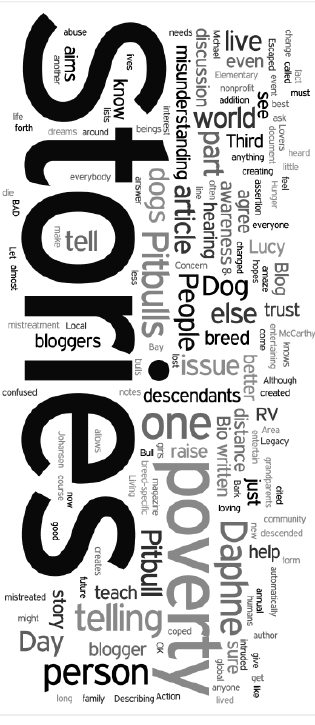I love Madelyn Blair. I have experienced her twice — at the 2005 and 2007 Storytelling Weekends in Washington, DC, and corresponded with her via e-mail. She is warm, funny, inspirational, and a strong voice of leadership in the organizational storytelling movement. Madelyn has gone way above and beyond what I’ve asked of my Q&A interviewees. I’ve asked them to respond to five questions out of an assortment of about a dozen; Madelyn responded to almost all of them. Her Q&A will appear over the next six days.
Bio of Madelyn Blair: Madelyn Blair, Ph.D., is the founder of Pelerei (a consulting firm that provide innovative management solutions to help organizations transform themselves) and has been its president since its inception in1988. Dr. Blair brings extensive line-management experience. She is expert in the fields of organizational development, knowledge management, instructional design, and research technique. Dr. Blair is an early advocate and practitioner of Appreciative Inquiry.  She developed the first content analysis of written performance evaluations. She designed and created the methodology of Information Flow Analysis, which Pelerei has used to create information strategies that are understandable, workable, and efficiently developed. She has designed and conducted custom-designed courses and other learning opportunities in such topics as leadership, gender, organizational change, knowledge management, communication, problem solving, and research design. She has done so for the classroom and for distance learning. She has extensive background and experience in the area of gender in the workplace and has worked with more than 20 organizations in developing programs to address the needs of women and men working together.
She developed the first content analysis of written performance evaluations. She designed and created the methodology of Information Flow Analysis, which Pelerei has used to create information strategies that are understandable, workable, and efficiently developed. She has designed and conducted custom-designed courses and other learning opportunities in such topics as leadership, gender, organizational change, knowledge management, communication, problem solving, and research design. She has done so for the classroom and for distance learning. She has extensive background and experience in the area of gender in the workplace and has worked with more than 20 organizations in developing programs to address the needs of women and men working together.
Most recently, she has become a national leader in the area of using storytelling in organizations. As a founding member of one of the leading organizations in this field, she is called upon to speak about how this powerful tool can be used in many different organizational and social settings.
She brings a practical approach to addressing business needs, often creating solutions with minimal resources by harnessing the energy of client teams. Dr. Blair has published extensively and is a popular speaker. She also loves climbing mountains.
Q&A with Madelyn Blair (Questions 1 and 2):
Q: How did you initially become involved with story/storytelling/narrative? What attracted you to this field? What do you love about it?
A: About 10 years ago Seth Kahan arranged for me to be invited to a brain-trust session on story in business. What I found was a group of about 30 people who seemed to understand that story was an important vehicle for communication that could be employed successfully in the business community. As I listened to their ideas, my understanding of story expanded, and I could see that I had been using story for a long time in my own work without knowing that was what I was doing. It was familiar to me, and as I learned more and more, I discovered the power of story in so many areas — direct communication of ideas, team building, understanding culture — all very useful to an organizational developer. After this brain-trust event, I began using story more consciously. As I used story more in my work, I became aware of the efficiency of story to convey ideas and concepts; the effectiveness of story to build solid, trusting relationships; the pleasure of story to engage audiences. It seemed that no matter what I was doing, when I could bring in story, my work was made easier. What’s not to love?
Q: The storytelling movement seems to be growing explosively. Why now? What is it about this moment in human history and culture that makes storytelling so resonant with so many people right now?
A: Life in the 21st century has begun to embrace the true complexity of life and the challenges that emerge from such complexity. Having been introduced to chaos theory, the world no longer sees itself the same. Problems no longer have smooth, clean edges, and trying to understand these more complex problems taxes the mind to just get the whole problem in the mind at one time. As one aspect of the problem enters the mind, another aspect leaves consciousness. At a time when the problems of the age are completely overwhelming, having a means to at least take the problem into the mind is essential.
Story has the wonderful ability to capture great complexity into a simple form, allowing listeners to take in the concepts, ideas, challenges, without feeling overwhelmed. From this first step, the mind has the opportunity to explore the apparent ambiguities, the natural linkages, the interactions, and more by exploring the story. Because the story holds the problem in a container that can reside in the mind in its entirety, the mind is never turned off by the enormity of the problem. Partitioning of large, complex problems was the manner in which such problems were dealt with in the past. This partitioning is no longer possible if the problem is to be properly dealt with. Thus, being able to hold the problem in the mind all at one time is a breakthrough. Often unconsciously but not always, I feel that people appreciate this ability of story to help them deal with the complex issues of life.
One could also say that story resonates because there has been a confluence of authors (Annette Simmons, Steve Denning, Rick Stone) and others (Karen Dietz, Seth Kahan, Victoria Ward) who have begun to articulate the power of story, offering ways and means of using story. This has been helpful as well, and one can never ignore this work. But in the end, it is the ability of story to capture the enormity of life’s issues and our nascent understanding of the complexity of the universe that has come together. Oddly enough, early civilizations and cultures saw and used the same power of story to capture and hold great truths in the simple container of the story. Just check out any of the great Greek myths.









